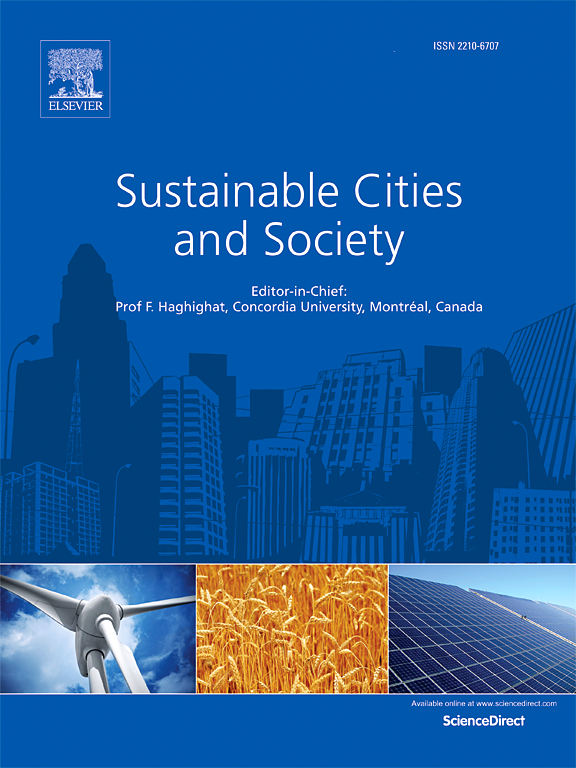从测量到法规:通过热弹性城市规划实现可持续城市冷却的可行方法
IF 10.5
1区 工程技术
Q1 CONSTRUCTION & BUILDING TECHNOLOGY
引用次数: 0
摘要
积极、科学地调控城市过度供暖是当务之急。然而,城市热环境研究与适用的城市规划策略之间存在理论与实践脱节,阻碍了减缓和适应工具的有效性。为了解决这一差距,本研究开发了一个理论框架来评估城市规划系统内可持续城市冷却调节的可行性。提出了控制热源和增加冷却源以实现城市可持续制冷的双管齐下和规划驱动的方法,并利用日平均温湿度指数(DMTHI)来捕获湿度和日地表温度动态。中国武汉主城区的一个案例研究验证了这一方法,确定了老城区中心和周边重工业园区的热应力热点。武汉城市降温的关键指标是平均建筑密度、工业用地面积百分比和绿地面积百分比。基于K-means方法,“控制热源”策略确定了五个调控区域:建筑形式控制、综合控制、土地利用控制、工业和建筑密度控制、建筑密度主导控制。“增加冷源”策略确定了四个调节区域:ndvi主导的冷却、综合绿地冷却、lpi_g主导的冷却和pland_g主导的冷却。这些选址方案提高了城市降温调节的效果。该研究为缓解城市热应激提供了见解,并为热弹性城市规划的发展提供了支持。本文章由计算机程序翻译,如有差异,请以英文原文为准。
From measurements to regulations: An actionable approach for sustainable urban cooling via heat-resilient urban planning
The proactive and science-based regulation of excessive urban heating is an urgent priority. However, a theoretical-practical disconnect persists between urban thermal environment research and applicable urban planning strategies, hindering the effectiveness of mitigation and adaptation tools. To address this gap, this study developed a theoretical framework to assess the feasibility of sustainable urban cooling regulation within urban planning systems. It proposed a two-pronged and planning-driven approach of controlling the heat source' and increasing the cooling source for sustainable urban cooling, and using the daily mean temperature-humidity index (DMTHI) to capture humidity and daily land surface temperature dynamics. A case study from the main urban area of Wuhan, China, validated this approach, identifying heat stress hotspots in the old city center and peripheral heavy industrial parks. The key indicators for urban cooling in Wuhan were the mean building density, percentage of industrial land area, and percentage of green space. Based on the K-means method, the 'controlling heat source' strategy identified five regulation zones: building form control, comprehensive control, land use control, industrial and building density control, and building density-dominated control. The 'increasing cold sources' strategy identifies four regulation zones: NDVI-dominated cooling, integrated greenspace cooling, LPI_G-dominated cooling, and PLAND_G-dominated cooling. These site-specific plans improve the efficacy of urban cooling regulation. This study provides insights for mitigating urban heat stress and supports the development of heat-resilient urban planning.
求助全文
通过发布文献求助,成功后即可免费获取论文全文。
去求助
来源期刊

Sustainable Cities and Society
Social Sciences-Geography, Planning and Development
CiteScore
22.00
自引率
13.70%
发文量
810
审稿时长
27 days
期刊介绍:
Sustainable Cities and Society (SCS) is an international journal that focuses on fundamental and applied research to promote environmentally sustainable and socially resilient cities. The journal welcomes cross-cutting, multi-disciplinary research in various areas, including:
1. Smart cities and resilient environments;
2. Alternative/clean energy sources, energy distribution, distributed energy generation, and energy demand reduction/management;
3. Monitoring and improving air quality in built environment and cities (e.g., healthy built environment and air quality management);
4. Energy efficient, low/zero carbon, and green buildings/communities;
5. Climate change mitigation and adaptation in urban environments;
6. Green infrastructure and BMPs;
7. Environmental Footprint accounting and management;
8. Urban agriculture and forestry;
9. ICT, smart grid and intelligent infrastructure;
10. Urban design/planning, regulations, legislation, certification, economics, and policy;
11. Social aspects, impacts and resiliency of cities;
12. Behavior monitoring, analysis and change within urban communities;
13. Health monitoring and improvement;
14. Nexus issues related to sustainable cities and societies;
15. Smart city governance;
16. Decision Support Systems for trade-off and uncertainty analysis for improved management of cities and society;
17. Big data, machine learning, and artificial intelligence applications and case studies;
18. Critical infrastructure protection, including security, privacy, forensics, and reliability issues of cyber-physical systems.
19. Water footprint reduction and urban water distribution, harvesting, treatment, reuse and management;
20. Waste reduction and recycling;
21. Wastewater collection, treatment and recycling;
22. Smart, clean and healthy transportation systems and infrastructure;
 求助内容:
求助内容: 应助结果提醒方式:
应助结果提醒方式:


